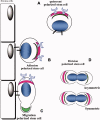Concise review: polarity in stem cells, disease, and aging
- PMID: 20641041
- PMCID: PMC2996084
- DOI: 10.1002/stem.481
Concise review: polarity in stem cells, disease, and aging
Abstract
Adult somatic stem cells are central to homeostasis in tissues that present with a high cellular turnover like the skin, intestine, and the hematopoietic system. It is thought that polarity is particularly important with respect to fate decisions on stem cell division (symmetric or asymmetric) as well as for the maintenance of stem cell adhesion and quiescence (interaction with the niche). Consequently the failure to establish or regulate stem cell polarity might result in disease or tissue attrition. Members of the family of small RhoGTPases are known to exert an important role in regulating cell polarity. We summarize and discuss here recent views on the role of cell polarity in somatic stem cell function, aging, and disease, concluding that targeting cell polarity might be a novel approach to ameliorate or even revert aberrant somatic stem cell function.
Figures


References
-
- Cappello S, Attardo A, Wu X, et al. The Rho-GTPase cdc42 regulates neural progenitor fate at the apical surface. Nat Neurosci. 2006;9:1099–1107. - PubMed
-
- Gupton SL, Gertler FB. Filopodia: The fingers that do the walking. Sci STKE. 2007;400:re5. - PubMed
-
- Etienne-Manneville S, Hall A. Rho GTPases in cell biology. Nature. 2002;420:629–635. - PubMed
-
- Manes S, Viola A. Lipid rafts in lymphocyte activation and migration. Mol Membr Biol. 2006;23:59–69. - PubMed
Publication types
MeSH terms
Substances
Grants and funding
LinkOut - more resources
Full Text Sources
Other Literature Sources
Medical

